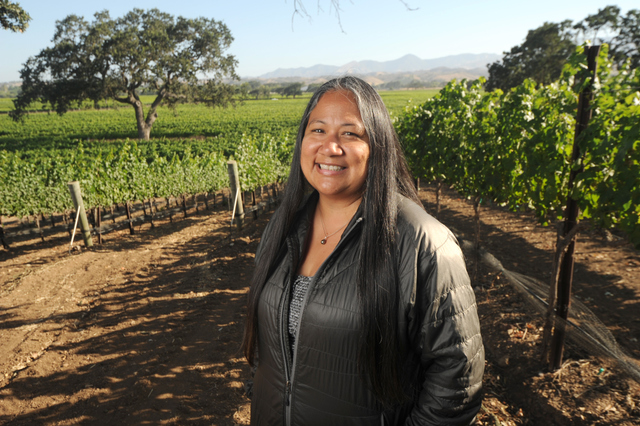Chumash Winery Is No Joke
Tribal Descendent Tara Gomez Impresses and Inspires with Kitá Wines

Given the sudden rise from abject poverty to relative wealth that the Santa Ynez Chumash experienced via their controversial casino, people are quick to assume that the tribe’s recently launched Kitá Wines is just another expensive hobby for the nouveau riche. Or, these aspersions continue, that winemaker Tara Gomez — a 41-year-old woman of Chumash heritage whose father is a major tribal figure — is a johnny-come-lately with more symbolism than skills.
Both notions are quite untrue, particularly the latter, for Gomez is far more qualified and experienced than many of her colleagues in the Santa Ynez Valley. The Santa Maria native graduated in 1998 with a winemaking degree from Fresno State (where she also got better in touch with her Native American roots). She interned at Fess Parker Winery during college, worked an enologist at J. Lohr Winery in Paso Robles for nine years, started her own label in 2001 (which she named Kalawashaq’ after her family’s historic village), and spent time working harvests in Europe before returning to Santa Barbara County in 2010 to start the Kitá project.
While Kitá Wines, which celebrated its first release about a year ago, does appear to be a well-funded operation — most evident in the increasing amount of square footage that it occupies in the Lompoc Wine Ghetto’s new Zotovich Building — it is certainly not an all-pomp, no-circumstance vanity project. The 3,500 case-per-year brand is very well considered (thanks to the meticulous methods of Gomez and her soon-to-depart assistant Tymari LoRe), truly ground-to-glass (thanks to the tribe’s ownership of the Camp 4 Vineyard, which was planted along Baseline Road near Highway 154 years ago by Parker, who sold it to the Chumash in 2010), and inspirational to other tribes across the state that are now developing their own brands (some of which are hiring Kitá for custom crush jobs).
Most critically, the Kitá project — which translates from the native Samala language to “our valley oak” — is producing an excellent series of wines, which range from a racy grenache blanc and creamy sauvignon blanc to a serious pinot noir, lip-smacking syrah, and can’t-keep-enough-in-stock cabernet sauvignon. And the awards are steadily piling up, most recently two gold medals for the 2011 syrahs and a silver for the 2011 pinot noir from the Los Angeles International Wine Competition.
Gomez attributes the accolades to her continual search for balance in the wines, a quest she feels particularly attuned to. “As Native Americans, being in balance with ourselves and our surroundings and living in harmony is something that comes naturally,” explained Gomez, who must refine that search with each vintage. “You never know what nature is going to give you. For other winemakers, that may be stressful, but that’s what I enjoy.”
When the tribe bought Camp 4 in 2010, Gomez began studying the 256-acre vineyard under the tutelage of the crew at Coastal Vineyard Care, and was ready to manage it herself by 2012. It’s a popular source of grapes for wineries all over the state, with more than 60 clients buying fruit every year, an arrangement that Gomez plans to keep in place even as Kitá slowly grows. The allure is because Camp 4 sits in a sweet spot climactically, just to the west of the rather warm Happy Canyon of Santa Barbara appellation, so most grape varietals, aside from cool-loving pinot noir and chardonnay, do well, including Rhône grapes like rousanne and syrah, Bordeauxs like merlot and cab franc, and Italians like sangiovese. “They all thrive,” said Gomez.
But for many Santa Ynez Valley residents not in the wine business, the name Camp 4 conjures up fears of rampant, unchecked development, as the vineyard is just one part of the tribe’s larger 1,400-acre property, which the Chumash want to annex into their reservation and use for housing. Gomez regularly deals with the “backlash,” so other than selling the wine in the places that the tribe owns — namely The Willows inside the casino, Root 246 inside Solvang’s Hotel Corque, and at the Hadsten House, also in Solvang — and a few other places in Santa Barbara, the Kitá sales team is focusing more on Los Angeles area and through the casinos and resorts of other tribes. They are also still debating if and where it would make sense to open a tasting room, with ideas ranging from the Funk Zone to Los Alamos all on the table.
Interestingly enough, given the disastrous historical connections between Native Americans and alcohol, there’s been zero backlash in that regard. “Of course, wine is in moderation,” Gomez explained, “and that’s what we support.”
With LoRe set to leave for Burgundy this summer, Gomez is fostering a new generation of Chumash descendents interested in wine, including career-track employees like Chris Unzueta and the many tribal volunteers who come to the winery and vineyard to learn and help out. With Gomez as the teacher, they’re all getting quite a classic and experienced education. “It’s important for us that our wines stay true to the varietal to showcase that grape and to highlight the beauty of the vineyard itself,” said Gomez. “It’s a special place.”
Call (805) 819-1372 or visit kitawines.com.



